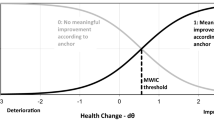Abstract
The polytomous unidimensional Rasch model with equidistant scoring, also known as the rating scale model, is extended in such a way that the item parameters are linearly decomposed into certain basic parameters. The extended model is denoted as the linear rating scale model (LRSM). A conditional maximum likelihood estimation procedure and a likelihood-ratio test of hypotheses within the framework of the LRSM are presented. Since the LRSM is a generalization of both the dichotomous Rasch model and the rating scale model, the present algorithm is suited for conditional maximum likelihood estimation in these submodels as well. The practicality of the conditional method is demonstrated by means of a dichotomous Rasch example with 100 items, of a rating scale example with 30 items and 5 categories, and in the light of an empirical application to the measurement of treatment effects in a clinical study.
Similar content being viewed by others
References
Andersen, E. B. (1966).Den diskrete målingsmodel af endelig orden med anvendelse på et socialpsykologisk materiale [The discrete measurement model of finite dimension with applications to data from social psychology]. Copenhagen: Statens Trykningskontor.
Andersen, E. B. (1970). Asymptotic properties of conditional maximum likelihood estimators.Journal of the Royal Statistical Society, Series B, 32, 283–301.
Andersen, E. B. (1972). The numerical solution of a set of conditional estimation equations.Journal of the Royal Statistical Society, Series B, 34, 42–54.
Andersen, E. B. (1973a).Conditional inference and models for measuring. Copenhagen: Mentalhygiejnisk Forlag.
Andersen, E. B. (1973b). Conditional inference and multiple choice questionnaires.British Journal of Mathematical and Statistical Psychology, 26, 31–44.
Andersen, E. B. (1973c). A goodness of fit test for the Rasch model.Psychometrika, 38, 123–140.
Andersen, E. B. (1977). Sufficient statistics and latent trait models.Psychometrika, 42, 69–81.
Andersen, E. B. (1980).Discrete statistical models with social science applications. Amsterdam: North-Holland.
Andersen, E. B. (1983). A general latent structure model for contingency table data. In H. Wainer & S. Messik (Eds.),Principals of modern psychological measurement (pp. 117–138). Hillsdale, NJ: Erlbaum.
Andrich, D. (1978a). A rating formulation for ordered response categories.Psychometrika, 43, 561–573.
Andrich, D. (1978b). Application of a psychometric rating model to ordered categories which are scored with successive integers.Applied Psychological Measurement, 2, 581–594.
Fischer, G. H. (1973). The linear logistic test model as an instrument in educational research.Acta Psychologica, 37, 359–374.
Fischer, G. H. (1974).Einführung in die Theorie psychologischer Tests [Introduction to the theory of mental tests]. Berne: Huber.
Fischer, G. H. (1977). Some probabilistic models for the description of attitudinal and behavioral changes under the influence of mass communication. In W. F. Kempf & R. Repp (Eds.),Mathematical models for social psychology (pp. 102–151). Berne: Huber.
Fischer, G. H. (1983). Logistic latent trait models with linear constraints.Psychometrika, 48, 3–26.
Fischer, G. H. (1989). An IRT-based model for dichotomous longitudinal data.Psychometrika, 54, 599–624.
Glas, C. A. W. (1989).Contributions to estimating and testing Rasch models (Doctoral dissertation, Technical University of Twente, Netherlands). The Hague: CIP-Gegevens Koninglijke Bibliotheek.
Haberman, S. J. (1974). Log-linear models for frequency tables with ordered classifications.Biometrics, 5, 589–600.
Masters, G. N. (1982). A Rasch model for partial credit scoring.Psychometrika, 47, 149–174.
McCullagh, P. (1980). Regression models for ordinal data (with discussion).Journal of the Royal Statistical Society, Series B, 42, 109–142.
McCullagh, P., & Nelder, J. A. (1983).Generalized linear models. London: Chapman and Hall.
Rasch, G. (1961). On general laws and the meaning of measurement in psychology.Proceedings of the IV. Berkeley symposium on mathematical statistics and probability, Volume 4 (pp. 321–333). Berkeley: University of California Press.
Rasch, G. (1965).Statistisk seminar (Statistical seminar). Copenhague: University of Copenhague, Department of Mathematical Statistics. (Notes taken by J. Stene).
Rasch, G. (1967). An informal report on a theory of objectivity in comparisons. In L. J. Th. van der Kamp & C. A. J. Vlek (Eds.),Psychological measurement theory (pp. 1–19). Leyden: University of Leyden. (Proceedings of the NUFFIC international summer session in science in “Het Oude Hof”, The Hague, July 14–28, 1966).
Tutz, G. (1989).Latent Trait-Modelle für ordinale Beobachtungen [Latent trait models for ordinal data]. Berlin: Springer.
Verhelst, N. D., Glas, C. A. W., & van der Sluis, A. (1984). Estimation problems in the Rasch model: The basic symmetric functions.Computational Statistics Quarterly, 1, 245–262.
Widowitz, E. (1987).Der Effekt autogenen Trainings bei funktionellen Erkrankungen [The effects of a relexation training on the functional syndrome]. Unpublished master's Thesis, University of Vienna, Department of Psychology.
Wright, B. D., & Masters, G. N. (1982).Rating scale analysis. Chicago: Mesa Press.
Zerssen, D. v. (1976).Klinische Selbstbeurteilungs-Skalen (KSb-S) aus dem Münchner Psychiatrischen Informations-System (PSYCHIS München) [The clinical self-rating scales (KSb-S) of the “Munich Psychiatric Information System” (PSYCHIS)]. Weinheim: Beltz.
Author information
Authors and Affiliations
Additional information
Work supported in part by the Fonds zur Förderung der Wissenschaftlichen Forschung under Grant No. P6414.
Rights and permissions
About this article
Cite this article
Fischer, G.H., Parzer, P. An extension of the rating scale model with an application to the measurement of change. Psychometrika 56, 637–651 (1991). https://doi.org/10.1007/BF02294496
Received:
Revised:
Issue Date:
DOI: https://doi.org/10.1007/BF02294496




